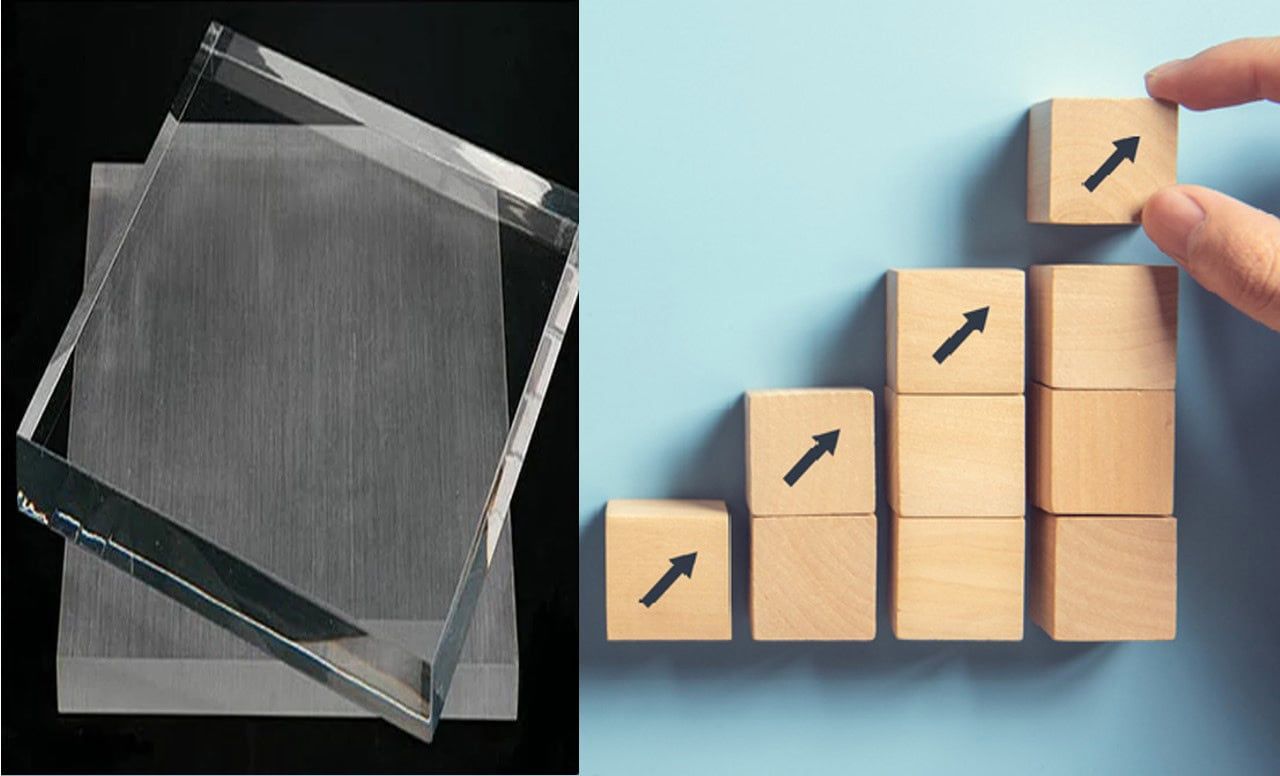From vibrant signs to high-performance automobile parts, acrylic sheets ease modern design, construction, and manufacturing. The market continues to evolve through technical advancements, sustainability, and shifting consumer preferences.
This article provides a comprehensive overview of the acrylic sheet market. It analyzed current trends, emerging challenges, and key opportunities. You’ll know growth patterns and potential innovations to shape the market landscape in 2025.
Global Market Overview: Acrylic Sheet Industry
The global acrylic sheet market size was valued at approximately $6.02 billion in 2023. It’s projected to reach $7.67 billion by 2029 with a growing CAGR (Compound Annual Growth Rate) of 4.10%.
Such growth within the forecast period is influenced by rising demand across industries (construction, automotive, signage, and medical).
a. North America
Likewise, the US leads the market due to its advanced manufacturing sector. Higher consumer spending on home improvements and automobiles also contributes. Acrylic sheets in modern architecture and advertising are significant growth factors.
b. Europe
Germany dominates the European market, particularly in automotive applications. Acrylic sheets are used in vehicle manufacturing and architectural designs.
c. Asia-Pacific
This region is expected to have the fastest growth. The booming construction and automotive industries in China, India, and Japan are leading the way. China, the largest market, is experiencing a surge in demand due to urbanization and infrastructure development.
d. Middle East and Africa
Growth is fueled by expanding construction projects. The same goes for rising investments in commercial spaces (partitional wall, interior décor, and furniture).
e. Latin America
Brazil and Mexico remain the key players within the continent. An increase in demand for advertising and signage applications pushes the use of acrylics.
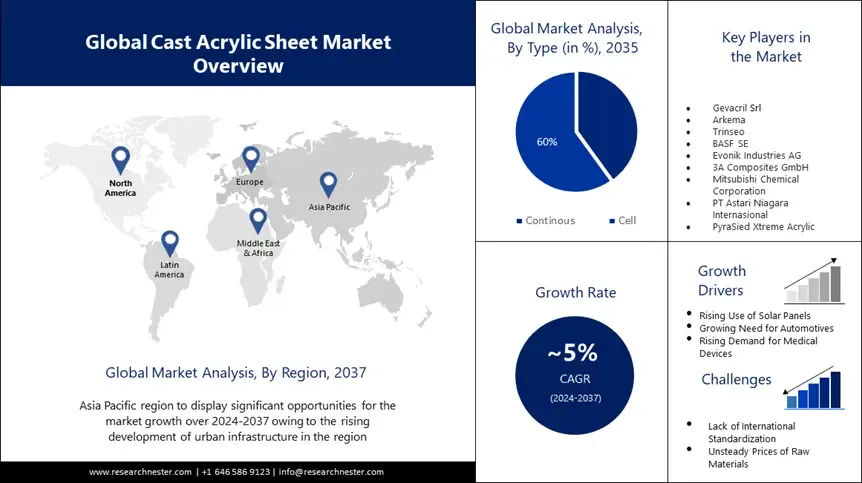
Key Market Drivers
- Construction Industry Growth: Acrylic sheets are widely used in windows, skylights, partitions, and façade claddings. They can harness the power of lightweight nature and durable structure.
- Automotive Industry Demand: Acrylic sheets are replacing traditional glass in windscreens, sunroofs, and instrument panels. It contributes to vehicle weight reduction and further fuel efficiency.
- Advertising and Signage Expansion: The rise of digital signage and outdoor advertising has skyrocketed the demand for high-quality acrylic sheets. Manufacturers have to develop different sheets.
- Technological Innovations: Advancements took place in UV-resistant coatings, anti-glare properties, and eco-friendly formulations. They expand applicability across electronics, healthcare, and furniture.
Market Segmentation by Acrylic Sheet Type
01. Extruded vs Cast Acrylic Sheets
Acrylic sheets are primarily categorized into the cast acrylic sheet segment and the extruded acrylic segment. Each offers distinct advantages based on its manufacturing processes and applications.
Cell cast acrylic sheet is widely used in high-end signage, medical devices, aquariums, and architectural glazing. Extruded acrylic is preferred for point-of-purchase displays, protective barriers, and furniture.
The global demand for continuous cast acrylic sheet continues to surge throughout luxury applications. Meanwhile, extruded acrylic sheets remain dominant in mass-market production.
02. Impact-Resistant Acrylic
It’s exclusively designed to withstand high-impact forces. The acrylic seems ideal for security glazing, protective shields, and automotive components. It has uses in sports arenas, transporting vehicles, and industrial safety barriers.
03. UV-Resistant Acrylic
It’s formulated to resist UV degradation, preventing yellowing and brittleness over time. Common uses include outdoor signage, skylights, and greenhouse panels. Advanced coatings, such as ACRYLITE Alltop, integrate UV filtering technology to enhance weather resistance.
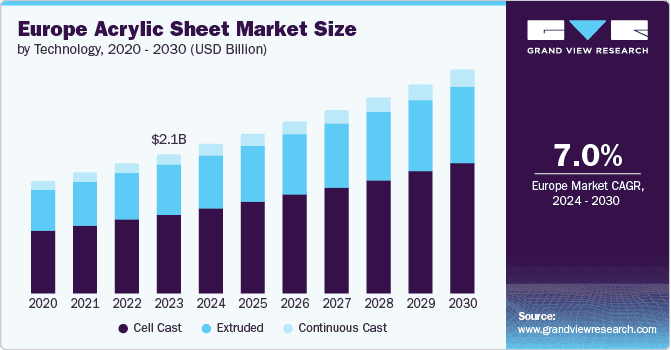
Market Segmentation by Acrylic Application
Acrylic sheets offer durability, optical clarity, and versatility, making them suitable for various industries. A detailed breakdown of acrylic sheet market analysis should give some insights.
A. Building and Construction
- Windows and Façades: Acrylic is used as a glass alternative in skylights, atriums, and façade claddings, offering UV resistance and thermal insulation.
- Roofing: Transparent acrylic panels allow natural light penetration, reducing the need for artificial lighting.
- Interior Design: Acrylic sheets are used in partitions, decorative panels, and furniture, enhancing aesthetics while maintaining structural integrity.
The global construction industry is increasingly adopting acrylic sheets for energy-efficient designs. Sustainable acrylic variants are gaining traction due to environmental concerns.
B. Automotive Industry
- Vehicle Lighting: Acrylic is widely used in headlights, taillights, and instrument clusters, offering superior optical clarity and impact resistance.
- Interior Panels and Dashboards: Acrylic enhances dashboard designs, providing scratch resistance and customization options.
- Exterior Components: Used in side mirrors, spoilers, and trims, contributing to lightweight vehicle designs for improved fuel efficiency.
The automotive and transportation industry is shifting towards lightweight materials to improve fuel efficiency. Custom acrylic designs are becoming popular in luxury and concept vehicles.
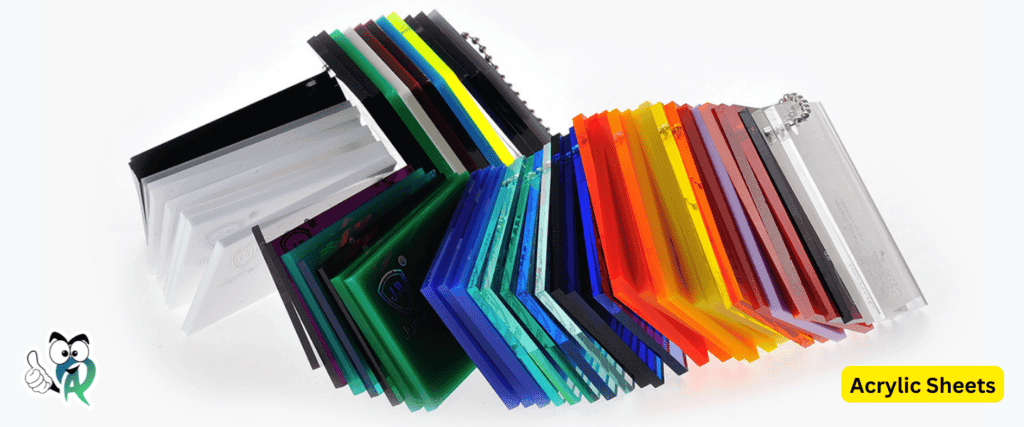
C. Advertising and Signage
- Retail Signage: Acrylic is preferred for storefront displays, menu boards, and promotional signage due to its shatter resistance and lightweight nature.
- Billboards and Outdoor Displays: Acrylic sheets provide UV resistance, ensuring long-lasting visibility.
- Digital Signage: Acrylic is used in LED-lit displays to enhance brightness and clarity.
Acrylic signage is replacing traditional glass due to cost-effectiveness and durability. Eco-friendly acrylic variants are emerging to meet the demands for sustainability.
D. Medical Industry
- Surgical Tools and Medical Devices: Acrylic is used in protective shields, surgical trays, and diagnostic instruments due to its biocompatibility and ease of sterilization.
- Prosthetics and Orthopedic Applications: Acrylic-based prosthetics provide lightweight and durable solutions.
- Hospital Equipment: Used in incubators, protective barriers, and medical displays, ensuring safety and hygiene.
Acrylic medical devices are gaining popularity due to cost-effectiveness and durability. Transparent acrylic shields are widely used in hospitals and laboratories.
E. Industrial Manufacturing
- Machinery Components: Acrylic is used in protective covers, machine guards, and industrial panels due to its impact resistance and clarity.
- Safety Shields and Barriers: Acrylic offers chemical resistance and durability, making it an ideal material for industrial workspaces.
- Fabrication and Molding: A completely integrated manufacturing process ensures precision and reliability for custom industrial designs.
Acrylic industrial components are gaining traction due to their high-performance durability. Recyclable acrylic materials are being explored for sustainable manufacturing.
Other Emerging Applications
- Furniture Design: Acrylic is used in tables, chairs, and decorative panels, offering modern aesthetics and durability.
- Art Installations: Artists use colored and textured acrylic sheets to create sculptures and exhibitions.
- Consumer Electronics: Acrylic is integrated into smartphone screens, protective casings, and display panels, enhancing durability and clarity.
Acrylic furniture is gaining popularity in luxury interior designs. Transparent acrylic panels are being used in high-tech consumer gadgets.

Market Opportunities and Growth Forecast for 2025
The acrylic sheet market is poised for significant expansion in 2025. Emerging market demand, technical advancements, sustainable initiatives, and diversification into new industries are leading the front.
Demand from Emerging Markets
The Asia-Pacific region, particularly China, India, and Southeast Asia, is about to hold the fastest growth.
- Urbanization and Infrastructure: Rapid urbanization in China and India drives demand for construction materials, including acrylic sheets for windows, façades, and roofing.
- Industrial Expansion: Southeast Asia is experiencing significant manufacturing growth, which in turn is increasing the demand for durable and lightweight materials in the automotive and electronics sectors.
- Government Investments: Infrastructure and building projects in India and Indonesia are driving demand for high-performance acrylic sheets in the construction and architecture sectors.
The Asia-Pacific acrylic sheet market is projected to grow at a CAGR of 5.0%, reaching $11.7 billion by 2032. China remains the largest consumer, with increasing adoption in advertising, automotive, and smart building applications.
Market Growth in End-Use Applications
Acrylic sheets are expanding into new industries, including renewable energy, healthcare, and smart technologies. Key growth factors include –
- Renewable Energy: Acrylic sheets are being integrated into solar panels and energy-efficient building materials, enhancing light transmission and durability.
- Healthcare Applications: The demand for medical-grade acrylic sheets is rising for surgical tools, diagnostic instruments, and protective barriers.
- Smart Technologies: Acrylic is increasingly used in interactive displays, IoT-enabled surfaces, and digital signage, supporting smart city initiatives.
- 3D Printing and Customization: The rise of 3D printing with acrylic sheets is enabling customized designs in architecture, automotive, and consumer electronics.
The healthcare and renewable energy sectors are expected to drive high-value applications, thereby increasing demand for specialized acrylic formulations. 3D printing adoption is accelerating, with manufacturers exploring customized acrylic solutions for prototyping and mass production.
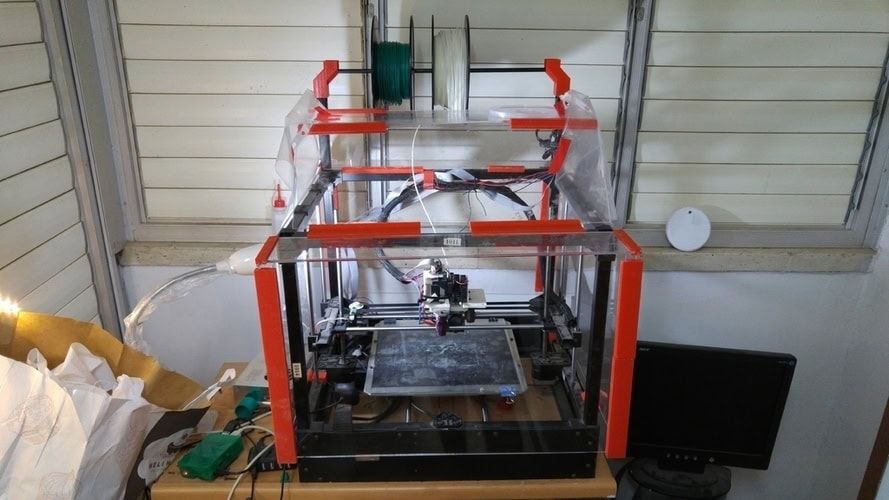
Sustainability as a Growth Driver
The push for eco-friendly materials is reshaping the acrylic sheet market, with recycled and biodegradable options gaining traction. Top growth factors are –
- Recycled Acrylic Sheets: Key players, such as Jumei Acrylic, are leading the shift toward sustainable sourcing, reducing their carbon footprint and plastic waste.
- Biodegradable Acrylic Innovations: New formulations are being developed to decompose naturally, minimizing environmental impact.
- Government Regulations: Policies promoting green building materials are encouraging manufacturers to adopt low-VOC and recyclable acrylic sheets.
Sustainable cell cast acrylic production is expected to grow, with major manufacturers investing in eco-friendly alternatives. Regulatory frameworks in Europe and North America are pushing industries toward low-impact materials, increasing demand for recycled acrylic sheets.
Technological Advancements and Innovation
Innovations in acrylic sheet production are enhancing performance, efficiency, and customization. It comes with the following key growth factors –
- Advanced Extrusion Techniques: New high-precision extrusion processes are improving sheet uniformity and durability.
- Improved Molding Processes: Hybrid manufacturing techniques are combining 3D printing and injection molding, enabling high-strength acrylic components.
- Additive Manufacturing: The integration of 3D printing in acrylic fabrication is reducing material waste and production costs.
Hybrid manufacturing methods are expected to streamline production, making custom acrylic solutions more accessible. 3D printing applications in architecture, automotive, and medical devices are expanding, driving new market opportunities.
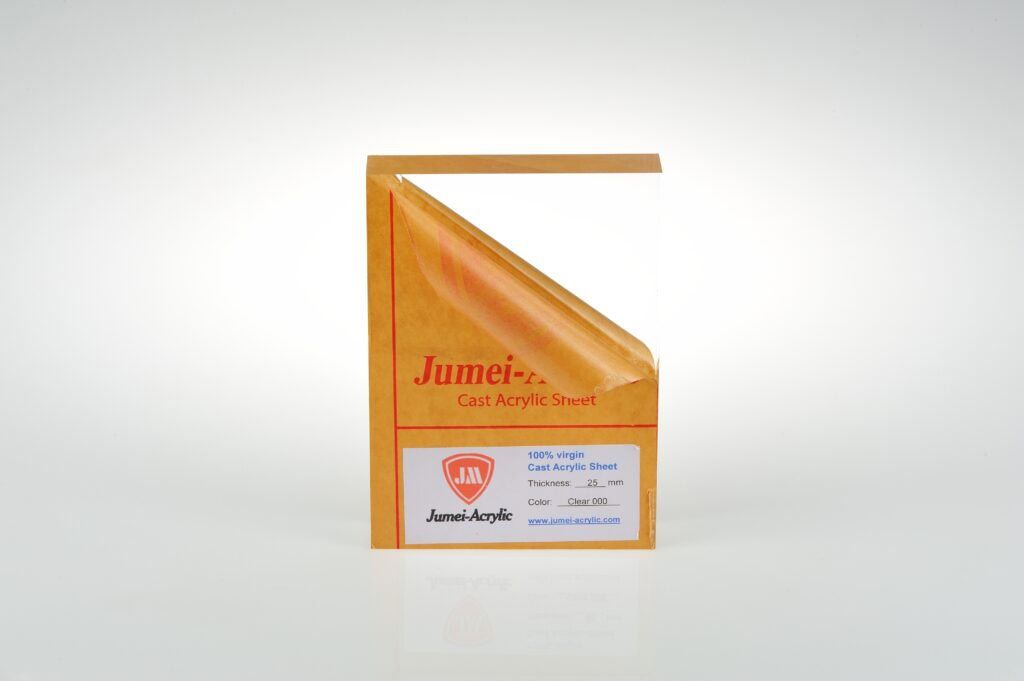
Future Trends in the Cast Acrylic Sheet Market
The acrylic sheet industry is undergoing significant transformations driven by sustainability, technology, customization, and increased adoption.
Sustainability and Eco-Friendly Alternatives
The push for sustainable acrylic solutions is reshaping the market. Manufacturers are increasingly adopting recycled acrylic sheets and bio-based raw materials.
- Recycled Acrylic Sheets: Companies like Recrylic have introduced certified recycled acrylic sheets, reducing carbon emissions by 90% compared to virgin acrylic.
- Circular Economy Initiatives: Manufacturers are implementing closed-loop recycling systems, ensuring acrylic waste is repurposed into new sheets.
- Bio-Based Acrylic: Innovations in bio-derived PMMA (polymethyl methacrylate) are emerging, offering lower environmental impact while maintaining performance.
The global recycled acrylic market is expected to grow significantly as industries prioritize eco-conscious materials. The retail and advertising sectors are shifting towards sustainable signage and displays, reducing their reliance on virgin acrylic.
Customization and Aesthetics in Market Demand
The demand for personalized acrylic solutions is rising, particularly in architecture, interior design, and advertising. Some foremost developments –
- Colored and Patterned Acrylic Sheets: Companies like Jumei Acrylic offer custom-printed acrylic sheets, catering to designers and architects.
- Laser-Cut and Engraved Acrylic: Advanced fabrication techniques allow for intricate designs, enhancing luxury interiors and retail displays.
- Textured and Decorative Acrylic: Innovations in patterned acrylic are expanding applications in furniture, signage, and artistic installations.
Luxury brands and high-end retails are adopting custom acrylic signage and displays to enhance brand aesthetics. Architectural firms are integrating decorative acrylic panels into modern building designs.
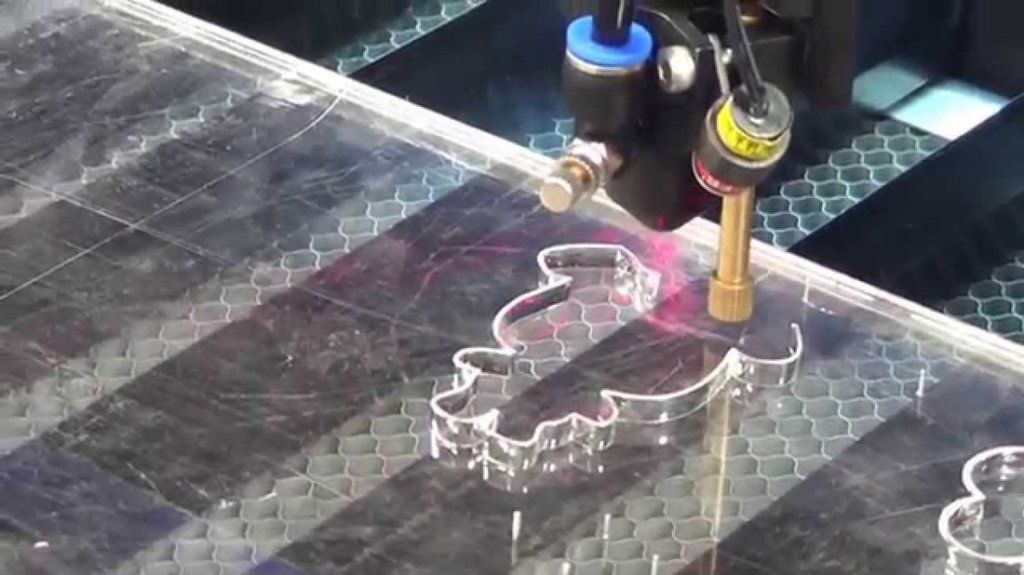
Smart Technologies for Market Research
Acrylic sheets are playing a growing role in smart buildings and digital advertising. Key developments –
- Smart Acrylic Panels: Used in interactive displays, solar panels, and sensor-integrated surfaces for energy-efficient buildings.
- Digital Signage Innovations: Acrylic is being incorporated into high-resolution LED displays, enhancing advertising and retail experiences.
- IoT-Enabled Acrylic Applications: Smart acrylic sheets are being developed for responsive environments, such as adaptive lighting and climate control.
Smart building projects are integrating acrylic-based solar panels and interactive surfaces to improve energy efficiency. Retailers and advertisers are leveraging smart acrylic displays for dynamic customer engagement.
Increased Market Share in the Automotive Sector
Acrylic sheets are gaining traction in vehicle interiors and exteriors, driven by lightweight and durability advantages. Noteworthy developments include –
- Automotive Lighting: Acrylic is widely used in headlights, taillights, and instrument clusters, offering high optical clarity and impact resistance.
- Dashboards and Interior Panels: Acrylic enhances dashboard designs, providing scratch resistance and customization options.
- Exterior Components: Used in side mirrors, spoilers, and trims, contributing to lightweight vehicle designs for improved fuel efficiency.
Electric vehicle manufacturers are adopting lightweight acrylic components to enhance energy efficiency. Luxury car brands are integrating custom acrylic interiors for premium aesthetics and durability.
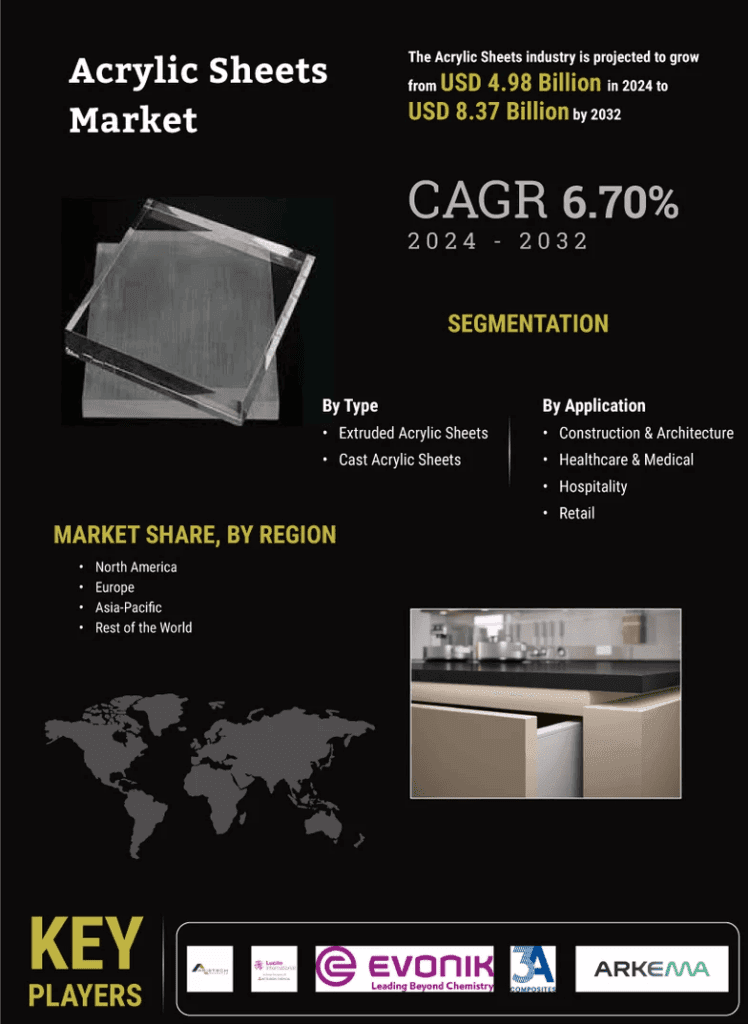
Strategic Initiatives: Mergers, Acquisitions, and Collaborations
The acrylic sheet market is witnessing further research and development activities through strategic mergers, acquisitions, and collaborations. Such joint ventures aim at market expansion for functional forms of business alongside aesthetic appeal (sanitary ware).
Plaskolite acquired the acrylic sheet division of Lucite International, strengthening its North American market presence. Lucite International is developing recyclable acrylics to reduce its carbon footprint and waste.
Evonik Industries AG introduced UV-resistant acrylic formulations to enhance durability for outdoor applications. Plaskolite is investing in impact-resistant acrylic sheets for the automotive and aerospace industries.
Arkema invested in bio-based cell-cast PMMA sheets, aligning with sustainability and the circular economy. Mitsubishi Chemical Corporation expanded its ACRYLITE® production facilities in Asia. It caters to the growing demand for acrylic glass, also known as acrylic polymer.
Challenges in the Acrylic Market Dynamics
The acrylic sheet industry faces several challenges that impact production, pricing, and competition. They can range from raw material price volatility, environmental and regulatory pressures, and competition from traditional materials.
Raw Material Price Volatility
Acrylic sheets are primarily made from methyl methacrylate (MMA), a petrochemical compound. The pricing of MMA is highly sensitive to fluctuating oil prices, supply disruptions, and trade policies.
- Price Instability: In Q1 2025, MMA prices in North America, Europe, and Asia-Pacific had a downward industry trend due to sluggish demand in the automotive and construction sectors.
- Supply Chain Disruptions: The imposition of new tariffs and trade restrictions has influenced global MMA trade flows, leading to uncertainty in procurement and pricing.
- Limited Inventory Strategies: Manufacturers are adopting minimal inventory levels and conservative trading practices to mitigate risks associated with price volatility.
Acrylic sheet manufacturers face higher production costs when MMA prices rise, leading to price adjustments for end-users. Supply chain disruptions can result in delays in acrylic sheet production, affecting industries reliant on consistent material availability.
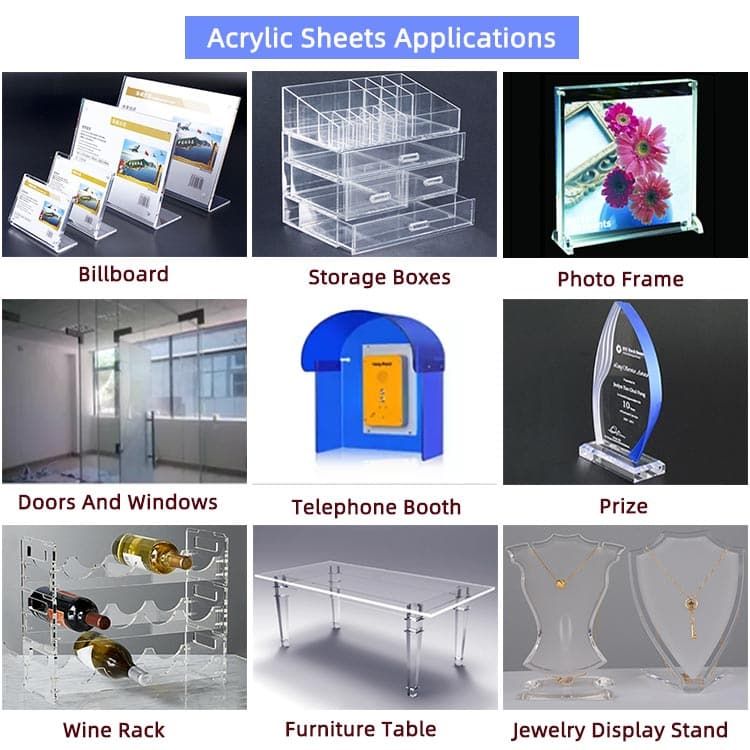
Environmental and Regulatory Challenges
The acrylic sheet industry is under increasing pressure to transition to sustainable production methods and comply with government regulations on plastic recycling and disposal.
- Carbon Footprint: Acrylic sheet production is energy-intensive, contributing to high carbon emissions.
- Recycling Limitations: Unlike some plastics, acrylic requires specialized recycling processes, which are not widely available, leading to higher landfill waste.
- Regulatory Compliance: Governments are enforcing strict regulations on plastic waste management, pushing manufacturers to adopt eco-friendly alternatives.
A leading acrylic sheet manufacturer should invest in bio-based acrylic formulations and closed-loop recycling systems. Sustainability initiatives are influencing consumer preferences. Plastic sheet business portfolio opts for recycled acrylic sheets over virgin materials.
Competitive Landscape of Alternative Materials
Acrylic sheets face growing competition from polycarbonate and PETG, which offer similar properties with added benefits. Some of the most difficult-to-deal-with issues –
- Polycarbonate vs Acrylic: Polycarbonate is stronger and more impact-resistant, making it a preferred choice for automotive, aerospace, and security applications.
- PETG vs Acrylic: PETG is more flexible and easier to thermoform, making it ideal for packaging and medical applications.
- Differentiation Through Innovation: Acrylic manufacturers must enhance product performance through UV-resistant coatings, impact-modified formulations, and sustainable alternatives.
Polycarbonate and PETG are gaining share in construction, automotive, and industrial sectors. Acrylic manufacturers are focusing on customization, sustainability, and fabrication for competitive advantage.
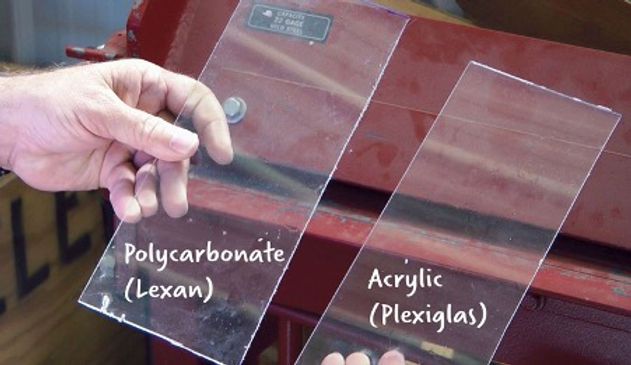
Conclusion
The acrylic sheet market thrives despite facing severe challenges like pricing volatility, environmental regulations, and fierce competition. Still, the projection reveals a massive surge in the next decades due to acrylic’s highly advantageous properties, collaborated with advancements.
Get the Best Quality Acrylic Sheets from JUMEI
As it happens, Jumei Acrylic owns some of the most advanced technology, innovation, and expertise. We have been thriving for 15+ years through commitment and satisfaction as the leading acrylic sheet manufacturer. Contact us to get assistance with your upcoming acrylic project.

